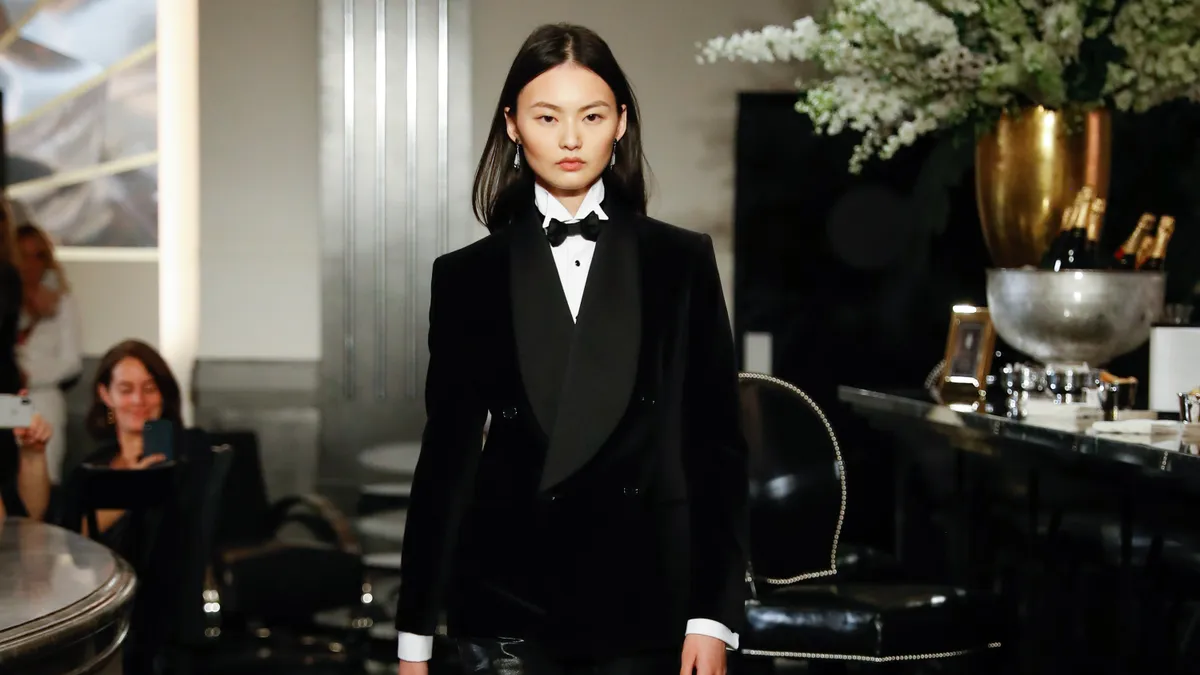Dive Brief:
- Ralph Lauren Corporation fourth quarter revenue was up 2% to $1.6 billion, and full-year revenue for fiscal 2024 was up 3% to $6.6 billion, according to a Thursday release.
- Q4 beat the company’s expectations by 1%, and FY24 revenue was in line with the high end of previously projected increases. However, the company forecasted a Q1 year-over-year slight revenue decline, per the release. In a conference call with investors, Jane Nielsen, the company’s chief operating officer and CFO, said Q1 and Q3 revenues are “expected to trend below our full year growth outlook” due to wholesale timing and “lower Q1 excess sales in North America and Europe.”
- The company also announced Nielsen’s departure as CFO, effective immediately. Justin Picicci succeeds her in the role as part of a multi-year succession plan, and Nielsen will stay on as COO through fiscal 2025.
Dive Insight:
Ralph Lauren’s brand-elevation strategy is still being well-executed, Wedbush analysts led by Tom Nikic said in emailed comments. Nonetheless, “the story has become cloudier with the announced departure of highly-regarded CFO Jane Nielsen,” Nikic said.
The company “has been one of the steadiest performers in our group in recent years, due in large part to the guiding hands of their strong executive team,” Nikic said, noting that Patrice Louvet, Ralph Lauren’s CEO, joined 7 years ago, while Nielsen joined 8 years ago.
“We believe that Ms. Nielsen is one of the strongest CFOs in the industry, and her track record with RL was exemplary,” said Nikic, who pointed in particular to the company’s average unit retail prices, which were “up a cumulative 70% during her tenure.”
“While promoting internally will likely aid the transition, we do note that Ms. Nielsen is a tough act to follow,” Nikic said.
Simeon Siegel, an analyst with BMO Capital Markets, said that while he commended Ralph Lauren’s 66.6% gross margin, which was up 480 basis points year over year in Q4, he wondered what was happening on the labor side, and said Nielsen’s management transition mattered.
Siegel said Nielson successfully turned the business around pre-COVID-19, before others in the space, and said she was “a rare leader who appreciates smaller can be healthier.”
Ralph Lauren increased its DTC average unit retail prices by 13% in Q4 and by 11% for the full year, per the release. The company said the rise was “on top of double-digit increases last year, driven by continued elevation of our product offering and favorable geographic and channel mix shifts.”
This is the 28th straight quarter that the company has reported year-over-year AUR prices increases, said Nikic, who noted that “the increases were broad-based across geographies” and that they helped contribute to the company’s 6% DTC comp store sales increase for both Q4 and the full year.
“They expect AUR to continue to rise in FY25…though it will be driven more by mix and reduced discounting, rather than like-for-like pricing,” Nikic said.
Regionally, Q4 sales in both North America and Europe were up 2%, despite a 2% wholesale decline in North America and a 6% wholesale decline in Europe. Asia was up 1% for the period.
For the full year, Asia revenue was up 10%, with China bringing in “more than 25% growth” for the period. Meanwhile, North America revenue was down 2% for the year and Europe revenue was up 7%.
“Supported by our increasing brand desirability and multiple engines of growth, this year’s performance underscores the strength of our long-term strategy, even as we navigate a highly dynamic global operating environment,” Louvet said in the release, adding that in fiscal 2025, the company would be “staying on offense” with brand and core product investments and a focus on “consumer-centric ecosystems in top cities globally.”
Earlier in May, Polo Ralph Lauren creative director Michael Rider stepped down. The company named Karen Brown, an 18-year company veteran, as its new senior brand creative director for Women’s Polo, but did not release further details.













